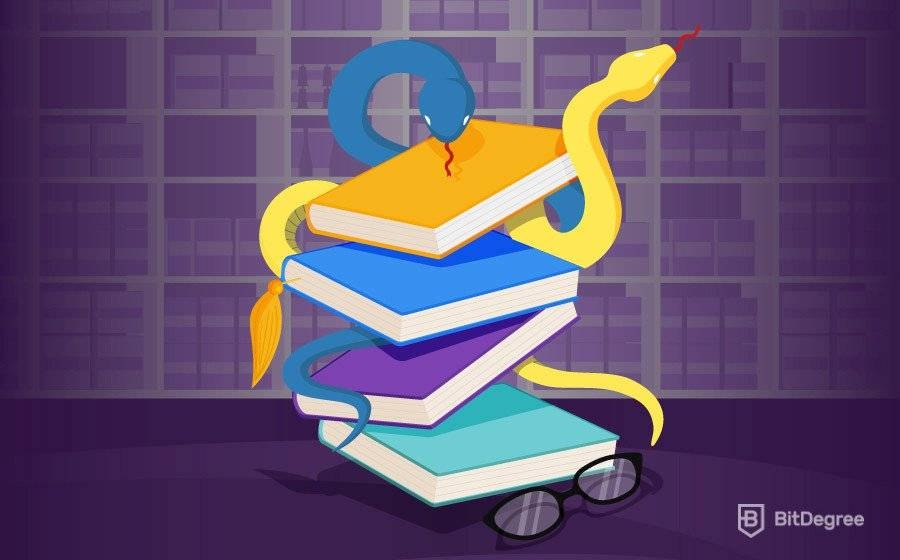Stop overpaying - start transferring money with Ogvio. Sign up, invite friends & grab Rewards now! 🎁

When you think of a library, you might immediately think of the rustic smell of old books and the quiet atmosphere that surrounds it. If we were to step into one of the Python libraries, we would see neatly organized shelves with modules that you pick up and use in your code. Therefore, these libraries are sources of various functionality. Developers avoid writing code for themselves by retrieving the pre-written and well-defined code from different libraries.
This tutorial reveals the top libraries from Python that programmers choose to import modules from and use in their code. If you are one of those people who enjoy working smart, not hard, you should see what these libraries have to offer!
And if you want to learn more about Python before getting started, let me guide you to our overview of the best Python courses offered by DataCamp. This learning platform is among the standouts in the data science field and will help you get a strong foundation before stepping into the big market.
Back to the point – by using Python libraries, you will be able to produce code efficiently and save precious time on having to write the entire script. However, let’s not get ahead of ourselves. The first step is to understand what a Python library is and some concepts related to it.
Table of Contents
- 1. Important Concepts to Learn First
- 2. What Are the libraries from Python?
- 3. API and Python: Best Libraries to Consider
- 3.1. Flask
- 3.2. Django
- 3.3. Falcon
- 3.4. Eve
- 4. AI and Python: Useful Libraries
- 4.1. TensorFlow
- 4.2. PyTorch
- 4.3. Theano
- 4.4. Keras
- 4.5. Scikit-learn
- 5. Round One: PyTorch vs TensorFlow
- 5.1. Famous Creators: Facebook and Google
- 5.2. Support for Windows
- 5.3. Support for Other Operating Systems
- 5.4. Differences in Computational Graphs
- 5.5. Visualization of Machine Learning Models
- 5.6. User Communities
- 5.7. Who Won?
- 6. What is NumPy?
- 7. Sklearn Library Defined: Usage Explained
- 8. Conclusions
Important Concepts to Learn First
Before diving into the explanations of different Python libraries, we should review a couple of concepts. For instance, deep learning is a process of machine learning. Do you know how people can learn from their mistakes? The same applies to computers. Deep learning aims to make the machine learn by example.
Latest DataCamp Coupon Found:Another relevant term is the neural network, resembling the human brain. In what way, you ask? Neural networks are a combination of algorithms that aim to mimic the way humans are capable of identifying patterns. Therefore, this concept takes human biology and applies it to the programming world to introduce image and speech recognition (only one of the options).
What Are the libraries from Python?
Firstly, you should understand that libraries for Python are not that different from regular libraries that you go to find and take captivating books. Both of them are collections of sources of information.

However, instead of books, you retrieve modules that you will apply during your coding process. All professional developers take advantage of well-documented modules. If there is an easy way of doing something, why would you not take this path?
Once you start researching Python libraries, you will be showered by the amount of the native and third-party libraries. There are many collections of modules available. Therefore, you might feel confused when you have to decide which of them to explore. If you are a programmer who tries to excel in several different domains, it might be challenging to choose a best-suited library.
You should already know that Python is a very versatile language. It is a gem in the programming world as its usage varies from data science, web development, and even machine learning. If you are a beginner Python programmer, we encourage you to take the Introduction to Python course on DataCamp or this BitDegree course to deepen your knowledge.
Overall, different libraries for Python include modules for specific areas. Shall we begin the expedition to find out what is TensorFlow, PyTorch, Numpy, Sklearn, and other popular libraries?
Before that, are you struggling to find a job as a Python programmer? In such cases, we highly recommend reading some of the Python interview questions that employers usually ask. If you don't answer them, you might seem unprepared for the job position. Let's say one of the Python interview questions requires you to speak about Python libraries. Even after reading this article, you will be able to present some key points about them.
API and Python: Best Libraries to Consider
API is an abbreviation for an application programming interface. It opens a window for interactions between applications via machine-to-machine communication. Python has frameworks that accelerate the API creation process. Therefore, our mission is to briefly discuss the most common libraries for Python that you can choose from:
Flask
- Flask is a fast-growing web framework, designed for a more efficient API designing process. Well, this is only one of the possible usages of Flask.
- In general, it is a framework for web application development.
- Flash is lightweight, offers support for unit testing and secure cookies for client-side sessions.
- Developers praise this framework for being well-documented, meaning that you will find many use cases to learn.
Django
- Django is another Python-based third-party web framework.
- Among the other Python libraries, Djangos' main purpose of this framework is to simplify the process of developing complex, database-driven websites.
- The Django library provides plenty of management tools. Therefore, developers will be able to produce portions of code without having to turn to other tools.
- The Django REST is the framework for creating Web APIs with minimal code.
Falcon
- Falcon is a lightweight, SWGI-compliant web framework, designed for building RESTful APIs.
- Beginners appreciate the well-documented tutorials that provide plenty of guidance for the first project creation.
- The Falcon runs on any hardware and relies only on two third-party dependencies.
Eve
- Eve is a free Python-based REST API framework, powered by Flask and Cerberus.
- It allows a speedy development of unique, feature-rich RESTful web services.
- The framework supports MongoDB and is highly compatible due to extensions.
AI and Python: Useful Libraries

The IT industry is expediting the development of smart machines, capable of presenting human-like behavior when it comes to learning. This simulation of human intelligence is powered by a variety of Python libraries that are specifically designed for boosting this computer science branch. If you want to make a machine think, learn, and be capable of problem-solving, you should memorize the libraries that can help you make a breakthrough:
TensorFlow
- TensorFlow is an open-source library.
- Numerical computation in this module integrates the usage of data flow graphs.
- They offer a different perspective on the conceptualization of mathematical actions.
- With this framework, you can create neural networks and train them.
- Neural networks are a crucial part of artificial intelligence as they are trained to learn by example. More information on TensorFlow is provided in other sections of this tutorial.
PyTorch
- PyTorch is an open-source library.
- It is a Lua-based framework, designed for building models and scaling production.
- This module provides a variety of machine learning algorithms.
- PyTorch lets users execute complex tensor computations.
- Also, it is the biggest rival of TensorFlow.
Theano
- Theano is a Python-based library for performing mathematical operations to multi-dimensional arrays.
- The framework uses GPU instead of the CPU, which leads to higher productivity levels.
- With Theano, developers create deep learning models or wrapper libraries.
- Another advantage is the framework’s capability of managing types of computation necessary for large neural network algorithms.
Keras
- Keras is a Python-based library for developing deep learning models.
- It is compatible with other Python libraries as well (TensorFlow or Theano too).
- The main purpose of this framework is the quick prototyping of neural networks.
- Developers can experiment with deep neural networks and train them.
Scikit-learn
- Scikit-learn or Sklearn is a Python-based library for building machine learning models.
- It provides many learning algorithms for regression, clustering, and classification.
- Sklearn is compatible with NumPy and SciPy. It means that you will be able to interoperate with different libraries for Python easily. More information on this library will be provided in the following sections.
Round One: PyTorch vs TensorFlow
A heated rivalry for superiority between these two libraries has been going on for some time. However, no one can deny the fact that they are the top Python libraries in town. Both PyTorch and TensorFlow are designed to provide modules for machine learning, deep learning, and neural network management.
Since both of these frameworks work in similar fields, it is understandable that there is some healthy competition between them. Let’s review their main differences, advantages, and try to settle this argument.
Famous Creators: Facebook and Google
The two giants in the IT business created these libraries. PyTorch is a masterpiece by Facebook, and it is Torch-based. And what is TensorFlow? It is a jewel provided by Google. It is based on Theano. In other words, both of these libraries have wealthy and famous parents.
Support for Windows
For some time, users of Microsoft Windows operating systems were not invited to the party of PyTorch. This open-source machine learning library released the PyTorch Windows support in April of 2018. TensorFlow took this step to lure Windows users earlier, back in 2016.
Support for Other Operating Systems
The list of supported systems still differs between these two Python libraries. Even though PyTorch Windows support addition was received very well, TensorFlow still has more to offer. While PyTorch supports Linux, macOS, and Window, TensorFlow is usable on Linux, macOS, Windows, Android, and JavaScript. Google released a TensorFlow.js 1.0 is for machine learning in JavaScript.
Differences in Computational Graphs
When trying to settle PyTorch vs TensorFlow battle, it is impossible not to mention the differences in the way they handle the computational graphs. Such graphs are crucial for the optimization of neural code networks. Why? Well, they visualize the flow of operations and information.
With PyTorch, programmers create dynamic graphs, designed by interpreting lines of code that represent the specific parts of the graph. TensorFlow chooses another approach for graph production. The graphs must follow the compilation process. After that, they have to run using the TensorFlow Execution Engine.
This sounds like more work, right? Because it is. If you want to create graphs using TensorFlow, you will be required to learn about the variable inspection. Additionally, PyTorch allows you to use the regular Python debugger. TensorFlow does not use the standard one. Therefore, if need to choose between these Python libraries and you want to create graphs without having to learn new concepts, PyTorch is the library for you.
Visualization of Machine Learning Models
First impressions are everything. When you are making a presentation about your project, it is useful to provide accurate and easy-to-follow visualization. TensorFlow offers developers TensorBoard, which allows the visualization of machine learning models. Programmers use this tool for error detection and for representing the preciseness of graphs. PyTorch does not have such functionality, but you can probably use non-native tools to reach similar results.
User Communities
These Python libraries also differ in their current popularity. Do not be surprised. TensorFlow has been around for longer, meaning that more programmers are using this framework for machine and deep learning purposes. Therefore, if you hit a block of issues that prevent you from continuing your project, the TensorFlow community is bigger than PyTorch.

- Easy to use with a learn-by-doing approach
- Offers quality content
- Gamified in-browser coding experience
- Free certificates of completion
- Focused on data science skills
- Flexible learning timetable

- High-quality courses
- Nanodegree programs
- Student Career services
- Nanodegree programs
- Suitable for enterprises
- Paid certificates of completion

- A wide range of learning programs
- University-level courses
- Easy to navigate
- University-level courses
- Suitable for enterprises
- Verified certificates of completion
Who Won?
We stated that we would end PyTorch vs TensorFlow discussion with a clear score. However, that is easier said than done. Programmers should choose the framework that suits their needs best. Additionally, this was a very brief introduction to both of these libraries. We cannot make assumptions based on several differences. Unfortunately, you will have to choose which framework is your new best friend.
What is NumPy?
You should be able to understand the general purpose of this library after learning its full name: Numerical Python. It means that the module handles numbers. NumPy is open-source software for the creation and management of multi-dimensional arrays and matrices. This library consists of a variety of functions for handling such complex arrays.
Table: Subjects offered by DataCamp vs BitDegree
So, what is NumPy? It is one of the Python libraries, which specializes in providing high-level mathematical functions for the management of multi-dimensional arrays. By retrieving modules from NumPy, you will complete accurate and precise calculations. Not to mention that you will significantly improve the usage of Python with these data structures.
Sklearn Library Defined: Usage Explained
The final example of libraries for Python is Sklearn, developed in 2007. It is last but not least, as it is also highly appreciated by developers who work with machine learning. Sklearn (also known as scikit-learn) is a library, consisting of algorithms for grouping a set of unlabeled objects, estimating relationships between variables, and determining the classification of new observations.
In other words, you can retrieve a large number of learning algorithms for more efficient machine learning. The Sklearn free Python library is a highly useful tool for statistical modeling and, of course, machine learning!

Did you know?
Have you ever wondered which online learning platforms are the best for your career?
Conclusions
There are many Python libraries to choose from, and, as always, you can take a look at the DataCamp course catalog to learn more about working with each of them in practice. It is the same as walking into a store that offers a vast selection of treats. How to decide which sweet treat, or in this case, library, you want? Well, different libraries provide modules for separate tasks. Therefore, you need to decide what type of modules you need for your code. Now, let’s briefly sum up this article for you:
- For API creation, developers choose from libraries for Python like Flask, Django, Eve, Falcon.
- For artificial intelligence and deep learning purposes, the best choices include these libraries: TensorFlow, PyTorch, Theano, Keras, Sklearn.
- The two top Python libraries are PyTorch and TensorFlow. They provide modules for machine learning, deep learning, and neural network management. They both lure programmers with similar treats, but there are some differences you need to consider. One of the most defining differences is that PyTorch allows developers to create dynamic graphs. TensorFlow graph-creation process is static and requires knowledge about more concepts.
- NumPy is another free Python library, providing high-level mathematical functions for the management of multi-dimensional arrays.
- Sklearn is yet another free Python library, closely-related to procedures of machine learning. It consists of algorithms such as support vector machines, gradient boosting, k-means, random forests, and DBSCAN.









